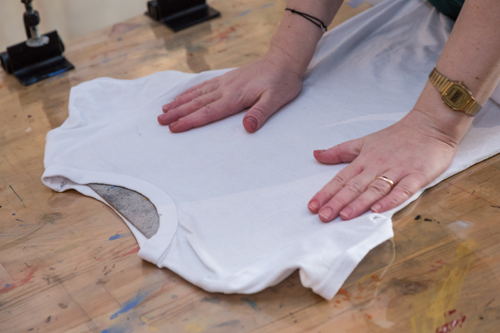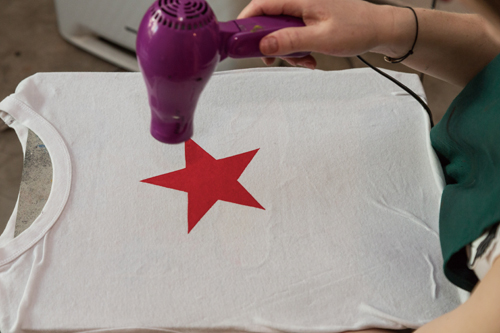
Now in her second year in Beijing, French native Sophie Nivet-Zeng teaches visual arts and comic book classes at Atelier for children aged 4 to 15 years old. After studying art in France and Scotland, she was drawn to screen printing for its versatility in the making of posters. “Many people would say that, in the act of painting, the gesture is very important,” she says. “But I also think that in the art of printing, the important part in the routine is the gesture.” For the clothing issue, Nivet-Zeng shows us how to use simple paper stencils and the screen printing technique to make a vintage-inspired t-shirt.
Materials
- Paper
- Pen
- Cutter
- Fabric paint
- Color pigments
- Silk screen (bought on Taobao)
- Plain cotton t-shirt
- Squeegee (a tool made of a rubber tip and wooden or plastic holding frame)
- Masking tape
- Cardboard or wooden surface
- Bowl or other container
- Plastic spoon
Resources
The following materials were all bought on Taobao:
Fabric paint: 白胶浆 bai jiao jiang (RMB 20-30 for 1kg)
Pigment: 色浆 se jiang (from RMB 54 per set)
Screen: 网版 wang ban
(RMB 15-55 depending on size)
Squeegee: 刮刀 gua dao
(RMB 0.6 per centimeter)
Masking tape can be found in art supply shops.

1. Insert the piece of cardboard or light plywood inside the shirt to straighten it. You can use pins to hold it in place. This is to avoid creases, which could affect the final design.

2. For the star, measure a spoonful of fabric paint and add it to the red color pigment in a bowl. Stir the mixture until only the red is visible. The intensity of the color depends on the amount of red pigment used. Place the mixture aside.

3. Take the piece of paper with the stencil on it and tape it to the outside of the screen. Place the screen to the top of the shirt. To center the design in the chest area of the shirt, place your hand at the bottom seam of the collar using the stencil as the reference point. Your hand should be inside the screen.

4. Another set of hands will be needed to firmly hold down the screen and pour the paint into the top part of the stencil.
5. Use the squeegee to spread the paint over the stencil once towards you, then lift the screen to check your results.

6. Immediately wash the screen, then dry it using a hair dryer. Dry the shirt as well to make sure the paint is dry with a hair dryer.
7. Wash the bowl. Add the fabric paint and the second color pigment (in this case, mint green). Stir again as in step 2.
8. Make a rectangular outline using the tape on the inside of the screen.

9. Spread the paint over the area within the tape, saturating every nook and cranny. It’s OK if the paint bleeds slightly over the tape.

10. On the outside of the screen, carefully align the ‘Made in China’ stencil to the paint-covered surface. At this point there is no need to tape it as the paint acts as an adhesive. This is done to get more details from the stencil.

11. Look at the screen from eye level with the shirt on the table, then carefully place the screen on the shirt.

12. Have someone hold the screen firmly. In one fluid movement, squeeze the paint through the screen and stencil, then lift.
13. Wash the screen and let it air dry for reuse in the future.
14. Allow the paint to dry.
15. Once dry, remove the cardboard or plywood from the t-shirt.
Stencil
Draw a design on plain paper, then cut it out using a box cutter. Do this slowly to prevent the paint from seeping through in unwanted areas. The areas that are not cut out block the paint from passing through. For the craft, Nivet-Zeng designed a star and “Made in China” circular stencil.
Tips
Use cotton or natural fabrics for screen printing, as they absorb better.
Use a small paintbrush in case some
details only got a little amount of paint. This should be done before the paint dries.
Check hands regularly for paint to avoid smears on the garment. Wash your hands whenever you spot paint on them.
Use an air purifier or a mask when handling fabric paint, as it can have a strong smell.
Photos by Mitchell Pe Masilun



